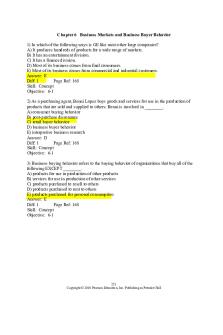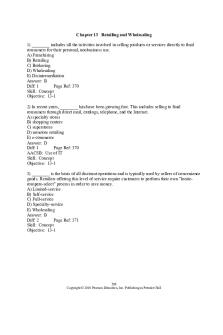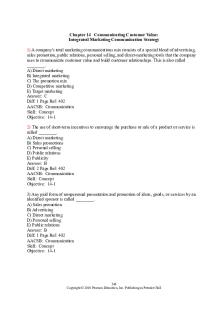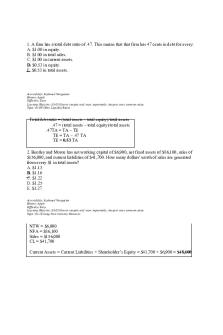Kotler Chapter 10 MCQ - Multiple choice questions with answers PDF

| Title | Kotler Chapter 10 MCQ - Multiple choice questions with answers |
|---|---|
| Course | Principles of Marketing |
| Institution | The University of the West Indies Mona |
| Pages | 37 |
| File Size | 206.9 KB |
| File Type | |
| Total Downloads | 35 |
| Total Views | 335 |
Summary
Chapter 10 Pricing Products: Understanding and Capturing Customer Value ________ is the amount of money charged for a product or service. A) Experience curve B) Demand curve C) Price D) Wage E) Salary Answer: C Diff: 1 Page Ref: 290 Skill: Concept Objective: 10- Price is the only element in the mark...
Description
Chapter 10 Pricing Products: Understanding and Capturing Customer Value 1) ________ is the amount of money charged for a product or service. A) Experience curve B) Demand curve C) Price D) Wage E) Salary Answer: C Diff: 1 Page Ref: 290 Skill: Concept Objective: 10-1 2) Price is the only element in the marketing mix that produces ________. A) revenue B) variable costs C) expenses D) outfixed costs E) stability Answer: A Diff: 1 Page Ref: 290 Skill: Concept Objective: 10-1 3) ________ is an important element in the marketing mix. It is the only element that does not represent costs. A) Current profit maximization B) Market share leadership C) Price D) Product quality leadership E) The target market Answer: C Diff: 1 Page Ref: 290 Skill: Concept Objective: 10-1
389 Copyright © 2010 Pearson Education, Inc. Publishing as Prentice Hall
4) Consumer perceptions of the product's value set the ________ for prices. A) demand curve B) floor C) ceiling D) variable cost E) image Answer: C Diff: 2 Page Ref: 291 Skill: Concept Objective: 10-2 5) Product costs set a(n) ________ to a product's price. A) demand curve B) floor C) ceiling D) break-even cost E) experience curve Answer: B Diff: 2 Page Ref: 291 Skill: Concept Objective: 10-2 6) Which of the following is a customer-oriented approach to pricing? A) value-based pricing B) sealed-bid pricing C) break-even pricing D) target profit pricing E) C and D Answer: A Diff: 2 Page Ref: 291 Skill: Concept Objective: 10-2 7) ________ uses buyers' perceptions of what a product is worth, not the seller's cost, as the key to pricing. A) Value-based pricing B) Value-added pricing C) Variable cost D) Price elasticity E) Product image Answer: A Diff: 2 Page Ref: 291 Skill: Concept Objective: 10-2
390 Copyright © 2010 Pearson Education, Inc. Publishing as Prentice Hall
8) In ________, price is considered along with the other marketing mix variables before the marketing program is set. A) Value-based pricing B) Cost-based pricing C) Variable costs D) Price elasticity E) Building the marketing mix Answer: A Diff: 2 Page Ref: 291 Skill: Concept Objective: 10-2 9) Value-based pricing is the reverse process of ________. A) variable cost pricing B) cost-plus pricing C) cost-based pricing D) good-value pricing E) value-added pricing Answer: C Diff: 2 Page Ref: 291 Skill: Concept Objective: 10-2 10) With ________, price is set to match consumers' perceptions of product value. A) variable cost pricing B) cost-plus pricing C) cost-based pricing D) value-based pricing E) every day low pricing Answer: D Diff: 2 Page Ref: 291 Skill: Concept Objective: 10-2 11) Measuring ________ can be difficult. A company might conduct surveys or experiments to test this in the different products they offer. A) price elasticity B) the demand curve C) perceived value D) break-even pricing E) quantity supplied Answer: C Diff: 3 Page Ref: 292 AACSB: Communication Skill: Concept Objective: 10-2
391 Copyright © 2010 Pearson Education, Inc. Publishing as Prentice Hall
12) Underpriced products sell very well, but they produce less revenue than they would have if price were raised to the ________ level. A) perceived B) value-based C) variable D) demand curve E) price-floor Answer: A Diff: 2 Page Ref: 292 Skill: Concept Objective: 10-2 13) If a seller charges ________ than the buyer's perceived value, the company's sales will ________. A) more; benefit B) more; suffer C) less; increase D) less; suffer E) none of the above Answer: B Diff: 2 Page Ref: 292 Skill: Concept Objective: 10-2 14) Some companies have adopted a ________ strategy, offering just the right combination of quality and good service at a fair price. A) Value-based pricing B) Good-value pricing C) Cost-plus pricing D) Low-price image E) None of the above Answer: B Diff: 1 Page Ref: 293 Skill: Concept Objective: 10-2 15) Wal-Mart is famous for using what important type of value pricing? A) competition-based pricing B) everyday low pricing C) cost-plus pricing D) break-even pricing E) penetration pricing Answer: B Diff: 2 Page Ref: 293 Skill: Concept Objective: 10-2
392 Copyright © 2010 Pearson Education, Inc. Publishing as Prentice Hall
16) ________ involves charging a constant, everyday low price with few or no temporary price discounts. A) High-low pricing B) Target pricing C) Cost-plus pricing D) EDLP E) Penetration pricing Answer: D Diff: 2 Page Ref: 293 Skill: Concept Objective: 10-2 17) ________ involves attaching features and services to differentiate a company's offers and to support charging higher prices.. A) Break-even pricing B) Target pricing C) Value-added pricing D) Cost-plus pricing E) Pricing-down Answer: C Diff: 1 Page Ref: 293 Skill: Concept Objective: 10-2 18) ________ is a company's power to escape price competition and to justify higher prices and margins. A) Variable cost B) Pricing power C) Target cost D) Fixed cost E) Unit cost Answer: B Diff: 2 Page Ref: 293 Skill: Concept Objective: 10-2 19) To maintain and increase a company's ________, a firm must retain or build the value of its marketing offer. A) variable cost B) pricing power C) target cost D) fixed cost E) image Answer: B Diff: 3 Page Ref: 293 Skill: Concept Objective: 10-2 393 Copyright © 2010 Pearson Education, Inc. Publishing as Prentice Hall
20) When there is price competition, many companies adopt ________ rather than cutting prices to match competitors. A) pricing power B) value-added strategies C) fixed costs D) price elasticity E) image pricing Answer: B Diff: 2 Page Ref: 293 Skill: Concept Objective: 10-2 21) Ryanair offers free flights to a quarter of its customers and rock-bottom prices to many of its other customers. Ryanair then charges for all extra services, such as baggage handling and inflight refreshments. Which of the following best describes Ryanair's pricing method? A) value-added pricing B) low-cost pricing C) cost-plus pricing D) high-low pricing E) image pricing Answer: B Diff: 2 Page Ref: 295 Skill: Concept Objective: 10-2 22) ________ pricing involves setting prices based on the costs for producing, distributing, and selling the product plus a fair rate of return for the company's efforts and risks. A) Value-based B) Fixed cost C) Cost-based D) Variable E) Skimming Answer: C Diff: 1 Page Ref: 295 Skill: Concept Objective: 10-3 23) Fixed costs ________ as the number of units produced increases. A) decrease B) increase C) divide in half D) remain the same E) increase at a diminishing rate Answer: D Diff: 2 Page Ref: 295 Skill: Concept Objective: 10-3 394 Copyright © 2010 Pearson Education, Inc. Publishing as Prentice Hall
24) Costs that do not vary with production or sales level are referred to as ________. A) fixed costs B) variable costs C) target costs D) total costs E) unit costs Answer: A Diff: 1 Page Ref: 295 Skill: Concept Objective: 10-3 25) Rent, electricity and executive salaries are examples of ________. A) fixed costs B) variable costs C) accumulated costs D) total costs E) marketing costs Answer: A Diff: 2 Page Ref: 295 Skill: Concept Objective: 10-3 26) Costs that vary directly with the level of production are referred to as ________. A) fixed costs B) variable costs C) target costs D) total costs E) unit costs Answer: B Diff: 1 Page Ref: 296 Skill: Concept Objective: 10-3 27) ________ are the sum of the ________ and ________ for any given level of production. A) Fixed costs; variable; total costs B) Fixed costs; total; variable costs C) Variable costs; fixed; total costs D) Total costs; fixed; variable costs E) Break-even costs; fixed; total costs Answer: D Diff: 2 Page Ref: 296 Skill: Concept Objective: 10-3
395 Copyright © 2010 Pearson Education, Inc. Publishing as Prentice Hall
28) SRAC is the acronym for which concept related to costs at different levels of production? A) strategic reasoning and costs B) short-run accounting costs C) short-run average cost D) strategic rights and company E) strategic revenues and costs Answer: C Diff: 2 Page Ref: 296 Skill: Concept Objective: 10-3 29) As production workers become better organized and more familiar with equipment, the average cost per unit decreases. This is called the ________. A) demand curve B) experience curve C) short-run average cost curve D) long-run average cost curve E) marginal utility Answer: B Diff: 1 Page Ref: 296 Skill: Concept Objective: 10-3 30) With a higher volume of product, most companies can expect to ________. A) gain economies of scale B) become less efficient C) see average costs increase D) have a straight, horizontal learning curve E) find competitors using the experience curve strategically Answer: A Diff: 2 Page Ref: 296 Skill: Concept Objective: 10-3 31) The experience curve reveals that ________. A) repetition in production lowers costs B) repetition in production enhances efficiency C) the average cost drops with accumulated production experience D) A, B, and C E) none of the above Answer: D Diff: 3 Page Ref: 296 Skill: Concept Objective: 10-3
396 Copyright © 2010 Pearson Education, Inc. Publishing as Prentice Hall
32) When a downward-sloping experience curve exists, a company should usually ________ the selling price of that product in order to bring in higher revenues. A) increase B) greatly increase C) decrease D) not alter E) none of the above Answer: C Diff: 3 Page Ref: 297 Skill: Concept Objective: 10-3 33) Which of the following is a risk a company takes when building a strategy around the experience curve? A) Competitors will likely not be able to meet the company's price cuts. B) Existing technologies are likely to become more expensive as the company expands. C) The method does not take competitors' prices into account. D) The method may cause consumers to become frustrated with changing prices. E) Aggressive pricing may give the product a cheap image, causing customers to lose interest. Answer: E Diff: 2 Page Ref: 297 Skill: Concept Objective: 10-3 34) A company building its pricing strategy around the experience curve would be likely to ________. A) price its products low B) price its products high C) engage in break-even pricing D) all of the above E) none of the above Answer: A Diff: 3 Page Ref: 297 Skill: Concept Objective: 10-3
397 Copyright © 2010 Pearson Education, Inc. Publishing as Prentice Hall
35) The company designs what it considers to be a good product, totals the expenses of making the product, and sets a price that adds a standard mark-up to the cost of the product. This approach to pricing is called ________. A) value-based pricing B) fixed cost pricing C) cost-plus pricing D) variable pricing E) skimming pricing Answer: C Diff: 1 Page Ref: 297 Skill: Concept Objective: 10-3 36) Lawyers, accountants, and other professionals typically price by adding a standard markup for profit. This is known as ________. A) variable costs B) cost-plus pricing C) value-based pricing D) break-even price E) penetration pricing Answer: B Diff: 2 Page Ref: 297 Skill : Concept Objective: 10-3 37) The simplest pricing method is ________. A) value-based pricing B) going-rate and sealed-bid pricing C) cost-plus pricing D) break-even analysis E) target profit pricing Answer: C Diff: 2 Page Ref: 297 Skill: Concept Objective: 10-3 38) Which of the following is a reason why markup pricing is NOT practical? A) Sellers earn a fair return on their investment. B) By tying the price to cost, sellers simplify pricing. C) When all firms in the industry use this pricing method, prices tend to be similar. D) This method ignores demand. E) With a standard markup, consumers know when they are being overcharged. Answer: D Diff: 3 Page Ref: 298 Skill: Concept Objective: 10-3
398 Copyright © 2010 Pearson Education, Inc. Publishing as Prentice Hall
39) One reason ________ remains popular is that sellers are more certain about costs than about demand. A) markup pricing B) variable pricing C) inelasticity pricing D) elasticity pricing E) penetration pricing Answer: A Diff: 2 Page Ref: 298 Skill: Concept Objective: 10-3 40) Price competition is minimized when all firms in an industry use which pricing method? A) variable pricing B) markup pricing C) elasticity pricing D) value-added pricing E) value-based pricing Answer: B Diff: 3 Page Ref: 298 Skill: Concept Objective: 10-3 41) Many people feel that ________ pricing is fairer to both buyers and sellers. Sellers earn a fair return on their investment but do not take advantage of buyers when buyers' demand becomes great. A) variable B) markup C) elasticity D) inelasticity E) penetration Answer: B Diff: 2 Page Ref: 298 AACSB: Ethical Reasoning Skill: Concept Objective: 10-3 42) Which of the following is a cost-based approach to pricing? A) value-based pricing B) going-rate pricing C) target profit pricing D) good value pricing E) A and C Answer: C Diff: 2 Page Ref: 298 Skill: Concept Objective: 10-3 399 Copyright © 2010 Pearson Education, Inc. Publishing as Prentice Hall
43) Break-even pricing, or a variation called ________, is when the firm tries to determine the price at which it will break even or make the profit it is seeking. A) competition-based pricing B) target profit pricing C) fixed cost pricing D) value-based pricing E) customer-based pricing Answer: B Diff: 1 Page Ref: 298 Skill: Concept Objective: 10-3 44) Target profit pricing uses the concept of a ________, which shows the total cost and total revenue expected at different sales volume levels. A) value-based chart B) break-even chart C) competition-based chart D) demand-curve E) unit cost Answer: B Diff: 2 Page Ref: 298 Skill: Concept Objective: 10-3 45) The break-even volume is the point at which ________. A) the total revenue and total costs lines intersect B) demand equals supply C) the production of one more unit will not increase profit D) the company can pay all of its long-term debt E) a firm's profit goal is reached Answer: A Diff: 3 Page Ref: 298 Skill: Concept Objective: 10-3 46) ________ pricing works only if that price actually brings in the expected level of sales. A) Elasticity B) Markup C) Variable D) Inelasticity E) Target profit Answer: E Diff: 3 Page Ref: 298 Skill: Concept Objective: 10-3
400 Copyright © 2010 Pearson Education, Inc. Publishing as Prentice Hall
47) Which of the following statements about break-even analysis is true? A) It is used to determine how much production experience a company must have to achieve desired efficiencies. B) It is a technique used to calculate fixed costs. C) It determines the amount of retained earnings a company will have during an accounting period. D) It is a technique marketers use to examine the relationship between supply and demand. E) It is calculated using variable costs, the unit price, and fixed costs. Answer: E Diff: 3 Page Ref: 298 Skill: Concept Objective: 10-3 48) As a manufacturer increases price, the ________ drops. A) target B) break-even volume C) cost-plus pricing D) total cost E) sales Answer: B Diff: 3 Page Ref: 299 Skill: Concept Objective: 10-3 49) Which of the following is an external factor that affects pricing decisions? A) the salaries of production management B) competition C) the salaries of finance management D) funds expensed to clean production equipment E) A, B, and C Answer: B Diff: 1 Page Ref: 299 Skill: Concept Objective: 10-4 50) ________ that influence pricing decisions include the nature of the market and demand and competitors' prices. A) Internal factors B) Elasticity factors C) External factors D) Target factors E) Domestic factors Answer: C Diff: 2 Page Ref: 299 Skill: Concept Objective: 10-4
401 Copyright © 2010 Pearson Education, Inc. Publishing as Prentice Hall
51) Companies may set prices low for which of the following reasons EXCEPT ________. A) to prevent competition from entering the market B) to stabilize the market C) to create excitement for a product D) to prepare for an easy exit from a market E) to match a competitor Answer: D Diff: 2 Page Ref: 299 Skill: Concept Objective: 10-4 52) In order to form a consistent and effective integrated marketing program, price decisions should be coordinated with each of the following EXCEPT ________. A) product design B) distribution C) competitors' prices D) promotion decisions E) marketing objectives Answer: C Diff: 2 Page Ref: 299 Skill: Concept Objective: 10-4 53) With target costing, marketers will first ________ and then ________. A) build the marketing mix; identify the target market B) identify the target market; build the marketing mix C) design the product; determine its cost D) use skimming pricing; penetrating pricing E) determine a selling price; target costs to ensure that the price is met Answer: E Diff: 2 Page Ref: 300 Skill: Concept Objective: 10-4 54) Price setting is usually determined by ________ in small companies. A) top management B) marketing departments C) sales departments D) divisional managers E) cross-functional teams Answer: A Diff: 2 Page Ref: 300 Skill: Concept Objective: 10-4
402 Copyright © 2010 Pearson Education, Inc. Publishing as Prentice Hall
55) Price setting is usually determined by ________ in large companies. A) top management B) divisional managers C) product line managers D) pricing departments E) both B and C Answer: E Diff: 2 Page Ref: 300 Skill: Concept Objective: 10-4 56) In industrial markets, ________ typically has the final say in setting the pricing objectives and policies of a company. A) the sales manager B) top management C) the production manager D) the finance manager E) the pricing department Answer: B Diff: 2 Page Ref: 300 Skill: Concept Objective: 10-4 57) In industries in which pricing is a key factor, ________ often set the best prices or help others in setting them. A) sales managers B) top managers C) production managers D) finance managers E) pricing departments Answer: E Diff: 2 Page Ref: 300 Skill: Concept Objective: 10-4 58) Under ________, the market consists of many buyers and sellers trading in a uniform commodity such as wheat, copper, or financial securities. A) pure competition B) monopolistic competition C) oligopolistic competition D) a pure monopoly E) anti-trust agreements Answer: A Diff: 2 Page Ref: 302 Skill: Concept Objective: 10-4
403 Copyright © 2010 Pearson Education, Inc. Publishing as Prentice Hall
59) Under ________, the market consists of many buyers and sellers who trade over a range of prices rather than a single market price. A) pure competition B) monopolistic competition C) oligopolistic competition D) pure monopoly E) socialism Answer: B Diff: 2 Page Ref: 302 Skill: Concept Objective: 10-4 60) Under ________, the market consists of a few sellers who are highly sensitive to each other's pricing and marketing strategies. A) pure competition B) monopolistic competition C) oligopolistic competition D) pure monopoly E) capitalism Answer: C Diff: 2 Page Ref: 302 Skill: Concept Objective: 10-4 61) Nonregulated monopolies are free to price at what the market will bear. However, they do not always charge the full price for a number of reasons. What is NOT one of those reasons? A) They don't want to attract competition. B) They want to penetrate the market faster with a low price. C) They have a fear of government regulation. D) They want to encourage government regulations. E) They want to please a large group of consumers. Answer: D Diff: 3 Page Ref: 303 Skill: Concept Objective: 10-4 62) The relationship between the price charged and the resulting demand level can be shown as the ________. A) demand curve B) variable cost C) target cost D) break-even pricing E) experience curve Answer: A Diff: 1 Page Ref: 303 Skill: Concept Objective: 10-4 404 Copyright © 2010 Pearson Education, Inc. Publishing as Prentice Hall
63) Consumers usually perceive higher-priced products as ________. A) out of reach for most people B) having high quality C) having high profit margins D) having cost-based prices E) being in the introductory stage of the product life cycle Answer: B Diff: 3 Page Ref: 303 Skill: Concept Objective: 10-4 64) Why do marketers consider prestige goods to be an exception to the typical demand curve? A) The demand curve for prestige...
Similar Free PDFs
Popular Institutions
- Tinajero National High School - Annex
- Politeknik Caltex Riau
- Yokohama City University
- SGT University
- University of Al-Qadisiyah
- Divine Word College of Vigan
- Techniek College Rotterdam
- Universidade de Santiago
- Universiti Teknologi MARA Cawangan Johor Kampus Pasir Gudang
- Poltekkes Kemenkes Yogyakarta
- Baguio City National High School
- Colegio san marcos
- preparatoria uno
- Centro de Bachillerato Tecnológico Industrial y de Servicios No. 107
- Dalian Maritime University
- Quang Trung Secondary School
- Colegio Tecnológico en Informática
- Corporación Regional de Educación Superior
- Grupo CEDVA
- Dar Al Uloom University
- Centro de Estudios Preuniversitarios de la Universidad Nacional de Ingeniería
- 上智大学
- Aakash International School, Nuna Majara
- San Felipe Neri Catholic School
- Kang Chiao International School - New Taipei City
- Misamis Occidental National High School
- Institución Educativa Escuela Normal Juan Ladrilleros
- Kolehiyo ng Pantukan
- Batanes State College
- Instituto Continental
- Sekolah Menengah Kejuruan Kesehatan Kaltara (Tarakan)
- Colegio de La Inmaculada Concepcion - Cebu















